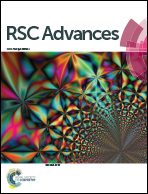Amorphous calcium phosphate nanowires prepared using beta-glycerophosphate disodium salt as an organic phosphate source by a microwave-assisted hydrothermal method and adsorption of heavy metals in water treatment
Abstract
Amorphous calcium phosphate nanowires (ACPNWs) were prepared using calcium chloride as the calcium source and β-glycerophosphate disodium salt (BGP) as the phosphate source by a microwave-assisted hydrothermal method. The effects of the hydrothermal temperature and concentrations of BGP and CaCl2 on the morphology and crystalline phase of the product were investigated. The as-prepared products were characterized by X-ray powder diffraction (XRD), transmission electron microscopy (TEM), and scanning electron microscopy (SEM). The possible formation mechanism of the ACPNWs is proposed. The experimental results indicate that the as-prepared ACPNWs exhibit large adsorption capacities for heavy metal ions (Cd2+, Cu2+, Pb2+, and Zn2+) and a highly selective adsorption activity for Pb2+ ions in an aqueous solution in the pH range from 4.5 to 8.5, implying that ACPNWs are a promising adsorbent for applications in water treatment.


 Please wait while we load your content...
Please wait while we load your content...